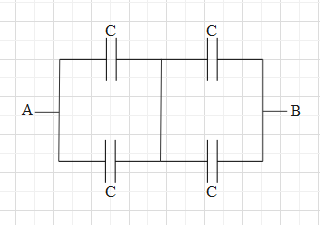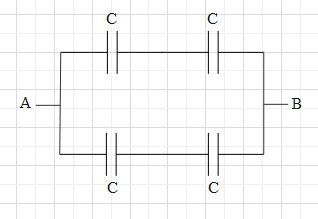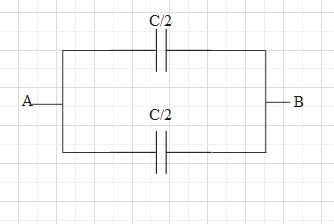
What is the equivalent capacitance of the system of capacitors between A and B as shown in the figure.

$\text{A}\text{. }\dfrac{7}{6}C$
$\text{B}\text{. 1}\text{.6}C$
$\text{C}\text{. }C$
$\text{D}\text{. none }$

Answer
576k+ views
Hint: The given circuit forms a wheatstone bridge. Therefore, check whether the given wheat stone bridge is balanced or not, i.e. whether the four capacitances satisfy the relation $\dfrac{{{C}_{1}}}{{{C}_{2}}}=\dfrac{{{C}_{3}}}{{{C}_{4}}}$. Then, use the formula for equivalent capacitance between two capacitances when they are series i.e. $\dfrac{1}{{{C}_{eq}}}=\dfrac{1}{{{C}_{1}}}+\dfrac{1}{{{C}_{2}}}$ and when they are in parallel i.e. ${{C}_{eq}}={{C}_{1}}+{{C}_{2}}$.
Formula used:
$\dfrac{{{C}_{1}}}{{{C}_{2}}}=\dfrac{{{C}_{3}}}{{{C}_{4}}}$
${{C}_{eq}}={{C}_{1}}+{{C}_{2}}$
$\dfrac{1}{{{C}_{eq}}}=\dfrac{1}{{{C}_{1}}}+\dfrac{1}{{{C}_{2}}}$
Complete step by step answer:
Let us first redraw the given figure as given below.

Now, from this figure we can see that the given combination makes up a wheat-stone bridge. When the fours capacitors given in the wheatstone bridge satisfy the relation $\dfrac{{{C}_{1}}}{{{C}_{2}}}=\dfrac{{{C}_{3}}}{{{C}_{4}}}$, the potential difference across the fifth capacitor (${{C}_{5}}$) is zero. And we say that the circuit is balanced.
Therefore, let us check whether the given wheat stone bridge is balanced. Here, all the capacitors have the same capacitors. That is, ${{C}_{1}}={{C}_{2}}={{C}_{3}}={{C}_{4}}=C$.
Therefore,
$\dfrac{{{C}_{1}}}{{{C}_{2}}}=\dfrac{C}{C}=1$ …. (i)
And
$\dfrac{{{C}_{3}}}{{{C}_{4}}}=\dfrac{C}{C}=1$ ….. (ii)
From (i) and (ii), we get that $\dfrac{{{C}_{1}}}{{{C}_{2}}}=1=\dfrac{{{C}_{3}}}{{{C}_{4}}}$
$\Rightarrow \dfrac{{{C}_{1}}}{{{C}_{2}}}=\dfrac{{{C}_{3}}}{{{C}_{4}}}$.
This means that the wheatstone bridge is balanced and the potential difference across the capacitor ${{C}_{5}}$ is 0.
Since the potential difference across the capacitor ${{C}_{5}}$ is zero, we can remove the capacitor and short the circuit at that position.
After this, the circuit will look as shown below.

Now, the capacitors ${{C}_{1}}$ and ${{C}_{2}}$ are parallel connections. When two capacitors are in parallel connection, the equivalent capacitance is equal to the sum of the individual capacitances.
This means that,
${{C}_{eq}}={{C}_{1}}+{{C}_{2}}$
$\Rightarrow {{C}_{eq}}=C+C=2C$.
Similarly, the capacitors ${{C}_{3}}$ and ${{C}_{4}}$ are also in parallel connection. Hence, the equivalent capacitance of these two is ${{C}_{eq}}={{C}_{3}}+{{C}_{4}}=C+C=2C$.
Now, the given circuit will look as shown below.

As we can see, the capacitances are in series. We two capacitors are in series connection, the reciprocal of the equivalent capacitance is equal to the sum of the reciprocals of the individual capacitances.
The means that equivalent capacitance of the given combination is $\dfrac{1}{{{C}_{eq}}}=\dfrac{1}{2C}+\dfrac{1}{2C}$.
$\Rightarrow \dfrac{1}{{{C}_{eq}}}=\dfrac{2}{2C}=\dfrac{1}{C}$
$\Rightarrow {{C}_{eq}}=C$.
Therefore, the equivalent capacitance of the given system of capacitors is C.
Hence, the correct option is C.
Note:
After the wheat stone bridge is balanced, instead of shorting the capacitor ${{C}_{5}}$, we can leave the circuit open as shown.

Now, ${{C}_{1}}$ and ${{C}_{3}}$ are series. Therefore, the reciprocal of the equivalent capacitance of these two capacitors will be $\dfrac{1}{{{C}_{eq}}}=\dfrac{1}{{{C}_{1}}}+\dfrac{1}{{{C}_{3}}}=\dfrac{1}{C}+\dfrac{1}{C}=\dfrac{2}{C}$.
$\Rightarrow {{C}_{eq}}=\dfrac{C}{2}$.
Similarly, the equivalent capacitance of ${{C}_{2}}$ and ${{C}_{4}}$ will be $\dfrac{C}{2}$.
Therefore, the circuit can be simplified as shown.

Now, the two capacitances are in parallel. Therefore, the equivalent capacitance will be ${{C}_{eq}}=\dfrac{C}{2}+\dfrac{C}{2}=C$.
Formula used:
$\dfrac{{{C}_{1}}}{{{C}_{2}}}=\dfrac{{{C}_{3}}}{{{C}_{4}}}$
${{C}_{eq}}={{C}_{1}}+{{C}_{2}}$
$\dfrac{1}{{{C}_{eq}}}=\dfrac{1}{{{C}_{1}}}+\dfrac{1}{{{C}_{2}}}$
Complete step by step answer:
Let us first redraw the given figure as given below.

Now, from this figure we can see that the given combination makes up a wheat-stone bridge. When the fours capacitors given in the wheatstone bridge satisfy the relation $\dfrac{{{C}_{1}}}{{{C}_{2}}}=\dfrac{{{C}_{3}}}{{{C}_{4}}}$, the potential difference across the fifth capacitor (${{C}_{5}}$) is zero. And we say that the circuit is balanced.
Therefore, let us check whether the given wheat stone bridge is balanced. Here, all the capacitors have the same capacitors. That is, ${{C}_{1}}={{C}_{2}}={{C}_{3}}={{C}_{4}}=C$.
Therefore,
$\dfrac{{{C}_{1}}}{{{C}_{2}}}=\dfrac{C}{C}=1$ …. (i)
And
$\dfrac{{{C}_{3}}}{{{C}_{4}}}=\dfrac{C}{C}=1$ ….. (ii)
From (i) and (ii), we get that $\dfrac{{{C}_{1}}}{{{C}_{2}}}=1=\dfrac{{{C}_{3}}}{{{C}_{4}}}$
$\Rightarrow \dfrac{{{C}_{1}}}{{{C}_{2}}}=\dfrac{{{C}_{3}}}{{{C}_{4}}}$.
This means that the wheatstone bridge is balanced and the potential difference across the capacitor ${{C}_{5}}$ is 0.
Since the potential difference across the capacitor ${{C}_{5}}$ is zero, we can remove the capacitor and short the circuit at that position.
After this, the circuit will look as shown below.

Now, the capacitors ${{C}_{1}}$ and ${{C}_{2}}$ are parallel connections. When two capacitors are in parallel connection, the equivalent capacitance is equal to the sum of the individual capacitances.
This means that,
${{C}_{eq}}={{C}_{1}}+{{C}_{2}}$
$\Rightarrow {{C}_{eq}}=C+C=2C$.
Similarly, the capacitors ${{C}_{3}}$ and ${{C}_{4}}$ are also in parallel connection. Hence, the equivalent capacitance of these two is ${{C}_{eq}}={{C}_{3}}+{{C}_{4}}=C+C=2C$.
Now, the given circuit will look as shown below.

As we can see, the capacitances are in series. We two capacitors are in series connection, the reciprocal of the equivalent capacitance is equal to the sum of the reciprocals of the individual capacitances.
The means that equivalent capacitance of the given combination is $\dfrac{1}{{{C}_{eq}}}=\dfrac{1}{2C}+\dfrac{1}{2C}$.
$\Rightarrow \dfrac{1}{{{C}_{eq}}}=\dfrac{2}{2C}=\dfrac{1}{C}$
$\Rightarrow {{C}_{eq}}=C$.
Therefore, the equivalent capacitance of the given system of capacitors is C.
Hence, the correct option is C.
Note:
After the wheat stone bridge is balanced, instead of shorting the capacitor ${{C}_{5}}$, we can leave the circuit open as shown.

Now, ${{C}_{1}}$ and ${{C}_{3}}$ are series. Therefore, the reciprocal of the equivalent capacitance of these two capacitors will be $\dfrac{1}{{{C}_{eq}}}=\dfrac{1}{{{C}_{1}}}+\dfrac{1}{{{C}_{3}}}=\dfrac{1}{C}+\dfrac{1}{C}=\dfrac{2}{C}$.
$\Rightarrow {{C}_{eq}}=\dfrac{C}{2}$.
Similarly, the equivalent capacitance of ${{C}_{2}}$ and ${{C}_{4}}$ will be $\dfrac{C}{2}$.
Therefore, the circuit can be simplified as shown.

Now, the two capacitances are in parallel. Therefore, the equivalent capacitance will be ${{C}_{eq}}=\dfrac{C}{2}+\dfrac{C}{2}=C$.
Recently Updated Pages
A man running at a speed 5 ms is viewed in the side class 12 physics CBSE

The number of solutions in x in 02pi for which sqrt class 12 maths CBSE

State and explain Hardy Weinbergs Principle class 12 biology CBSE

Write any two methods of preparation of phenol Give class 12 chemistry CBSE

Which of the following statements is wrong a Amnion class 12 biology CBSE

Differentiate between action potential and resting class 12 biology CBSE

Trending doubts
What are the major means of transport Explain each class 12 social science CBSE

Which are the Top 10 Largest Countries of the World?

Draw a labelled sketch of the human eye class 12 physics CBSE

How much time does it take to bleed after eating p class 12 biology CBSE

Explain sex determination in humans with line diag class 12 biology CBSE

Explain sex determination in humans with the help of class 12 biology CBSE




